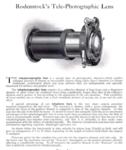Before anyone jumps down my throat, I'm not actually interested in using a LF zoom, just intellectual curiosity.
Anyway, the other day I was wondering about the various lens types common on smaller formats--telephoto, retrofocal, zoom (i.e. varifocal and parfocal). I was curious about their application in large format. Telephoto is easy--there are a number of well know lenses in the telephoto type. Retrofocal, I don't know, I could see their use with people using recessed board so they can focus or perform movements with wide lenses, but I've not seen any lenses that are explicily retrofocal.
Zooms, I also didn't see anything. I assumed that no such lenses existed for large format. Then I stumbled across this brochure:
https://www.pacificrimcamera.com/rl/00718/00718.pdf
And the page for their telephoto lens thows this:

As best as I can tell shrinking or lengthing the tube changes the zoom ratio. Am I misreading anything here? Or is this telephoto, really a telephoto zoom lens? Are there other zooms in the LF world?
(BTW, searching for 'large format zoom" brings tons of hits for large format cine camera lenses, not really anything about large format still cameras.)



 Reply With Quote
Reply With Quote

Bookmarks